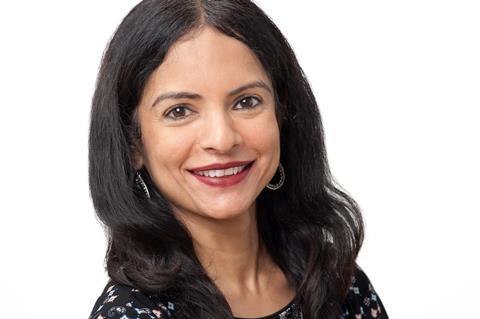The world is moving to more natural ways to access the power of computing, says Android TV senior director of product management and IBC2019 keynote speaker Shalini Govil-Pai.
It’s been an eventful year for Android TV. If you had to select a few of the most important milestones, what would they be and why?
Focusing on product excellence. First and foremost, a TV platform has to have strong quality assurance to meet user expectations. We’ve really prioritised the reliability and quality of Android TV. We have a team based in Zurich dedicated to ensuring a seamless experience, and there is a concerted effort to make the experience delightful. The results of this have been now been acknowledged by our user base and have also showcased a good rise in engagement.

The next would be operator momentum. Our goal as a platform is to make our partners successful based on their business models. Android TV’s Operator Tier was announced at IBC2016. This was the version that enabled operators to have more control and helped them save time and money in their deployments.
The key element was giving operators the flexibility to build a custom launcher and replace the Google standard launcher, thus owning the user experience while still offering all the capabilities of the platform: the Google Assistant, the app ecosystem through Google Play, and Chromecast. This allows consumers to access their streaming media and cable media in one place, enabled by voice search and casting.
As of 2019, we have 140+ pay-TV operator partners worldwide. Notable partners include LG U+, Bouygues Telecom and Telecom Italia.
The third factor is growing the content and app ecosystem. For users, content is king. Our focus is on making content discovery easier for users, and enabling content providers to build optimised experiences for new audiences and markets. Today’s consumers demand media and gaming, but we’re also exploring how we can bring other experiences to TV such as communication, education, health and fitness.
Finally, providing our OEM partners with the ability to innovate is core to our platform, and this space is evolving more quickly than one can imagine. Hardware manufacturers continue to bring new devices to the market, and introduce new innovation through new form factors (i.e. smart TVs, projectors, set-top boxes, soundbars).
Today, 6 of 10 top smart TV OEMs use the Android TV platform. Notable partners are Sony, Nvidia, TCL, Xiaomi, Hisense and Funai (Philips).
For the unfamiliar, how would you describe Android TV’s specific niche in what is an increasingly competitive smart TV environment?
Our goal is to ensure our partners can provide a best-in-class platform and experience for their users – one that enables them to delight and reach new audiences. We work closely with partners across different form factors to make that vision a reality.
For operator partners, in particular, we learned early on that flexibility and customisation are key components for our engagements. Our operator tier has allowed our partners to customise the launcher user experience with their branding and content. Since then, we have seen extraordinary momentum due to offering a unique, differentiated solution in the marketplace. We are also working on turnkey tools for faster time to market and offering more monetisation technologies.
We are continuing to focus on our retail form factors with smart TVs and streaming media players. Our home screen is a content-first guide experience. Users are able to turn on their devices and find engaging content from multiple apps right from the home screen. With the Google Assistant for Android TV, we’ve enabled new experiences including and beyond watching content – and we’re constantly improving and adding new capabilities.
You have recently spoken elsewhere about the possible demand for voice control of smart TVs. What is your expectation for this technology, including with relation to Android TV’s own R&D?
The world is moving to more natural ways to access the power of computing, particularly with voice. This is especially true in people’s homes and living rooms. Google is investing in voice technology through the development of the Google Assistant, which comes built in with Android TV. Our team works closely with the Google Assistant team to ensure that user needs in the living room, especially when it comes to being entertained and educated, are met.
What tend to be viewers’ main requirements when they approach the purchase of a new smart TV in terms of core control and functionality?
Our users really look for the combination of a great hardware product that’s integrated with an experience that is simple and intuitive, and has all of their favourite content. With 6 of the top 10 Smart TV retailers using Android TV, our users have a wide range of products they can choose from to meet their needs in terms of hardware specs and pricing. In addition, they have access to over 500,000 TV shows and movies available on Android TV, and the ability to cast their own content from their smartphones to the big screen so our viewers are able to watch what they want, when they want it. The Google Assistant on Android TV also makes it easier to search for new content and ask for recommendations.
In what primary ways will you be looking to grow Android TV’s market reach over the next few years?
We’ll continue to bring innovations to the platform and improve the quality and reliability of the Android TV experience. We also strive to make the overall user experience better, including on the home screen and the Play store, and make it easier for users to find and purchase content. We believe that providing the best smart TV experience possible, and working closely with our operator and OEM partners to offer more choice, will lead to more users choosing the Android TV ecosystem. This will ultimately help our partners build successful businesses and developers reach a new audience.
What message will your IBC2019 keynote address have for the future of broadcasting delivery as a whole?
Android TV solves problems for operators at scale by providing a standardised platform that improves time to market and costs. Android TV does this without dictating their user experience; operators know their subscribers best and are best-suited to build a phenomenal experience for them. We are looking into providing turnkey tools for even faster time to market and monetisation solutions.
As a platform, our success depends on the success of our partners. Pay TV is a business with thin margins, so finding ways to help partners continue creating great TV experiences is really important to us. With a fully integrated ad platform, Android TV brings additional revenue opportunities for operators that also give subscribers access to streaming content, powerful search and voice technologies.
Which areas of technology are you personally most excited to find out more about at IBC2019?
For decades, we’ve seen the same use cases of media and gaming for the biggest screen in your home. Android TV is a powerful platform, and we’re excited to see and build new innovations in emerging areas for the living room.
- Shalini Govil-Pai will deliver the keynote session The road from Pixar to Android TV and beyond on Saturday 14 September at 12:30pm in the Forum.





























No comments yet